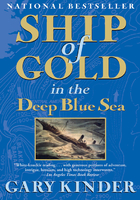A WONDERFUL FISH
If you believe such things, there's a beast that does the bidding of
Davy Jones. A monstrous creature with giant tentacles that'll
suction your face clean off, and drag an entire ship down to the
crushing darkness. The Kraken…
—PIRATES OF THE CARIBBEAN
On October 26, 1873, Theophilus Piccot and an assistant known to history as Daniel Squires rowed out for herring over the icy-cold surface of Portugal Cove in Newfoundland's Conception Bay. Piccot knew the bay well. He had fished these waters hundreds of times. But on this trip, he and Squires saw something unusual floating in the distance below the Newfoundland cliffs.
It was quite large.
It looked, at least from a distance, something like an abandoned sail or debris from a wreck.
Hoping for valuable salvage, they rowed over. The two men found a quivering mass unlike anything they'd ever seen. They poked the mass with a gaff. It was a living creature. It reared its beak at them, which the men later said was "as big as a six-gallon keg." The animal's beak rammed the bottom of their skiff. From its head shot out "two huge livid arms." The animal then began to "twine" its arms around the boat.
The two feeding tentacles, several times the men's height and covered with serrated rings inside the suckers, shot out over the gunwales of the skiff, seeming to move with the speed of a lightning bolt. Fortunately, Piccot had a hatchet on board. He hacked away. He severed both tentacles, as thick as his muscular wrists, from the rest of the creature. The animal shot out gallons of ink which "darkened the water for two or three hundred yards." Then it sped away as the men watched. It was never seen again.
Piccot and Squires returned to port in St. John's, bringing with them what might well be one of the world's best-ever fish stories. They also brought back both severed organs, which had begun to stink almost unbearably. One they destroyed, not knowing its scientific value.
The other was saved by the local rector, who received the flesh as though he had received the stone with the Ten Commandments. Moses Harvey, like so many educated Victorians, was an amateur naturalist. He had followed the decades-long scientific controversy over the existence of a fabled sea monster. He may well have read, only months earlier, a paper by A. S. Packard published in The American Naturalist arguing for the existence of a very large animal, Architeuthis, in the North Atlantic. The animal had been given its scientific name years earlier by a Danish scientist, but there were still those who contested its existence.
Harvey understood the importance of having a genuine specimen. He had the 19-foot-long lump of flesh exhibited in the town's museum. He coiled the tentacle like a snake and had a drawing made. He also had a photograph taken. He sent a written report across the sea to the British Annals and Magazine of Natural History. The journal published the package under the title "Gigantic Cuttlefishes in Newfoundland."
The animal was, of course, not a cuttlefish (a small kind of cephalopod) but a huge squid. The misidentification is not surprising, given the mystery that then surrounded the species. Harvey's submission ended a scientific controversy that had existed for centuries and grown increasingly personal and even bitter as the nineteenth century progressed. Seafarers had long claimed that a massive, vicious animal lived in the deep sea. They said that the animal sometimes attacked ships and could tear a man to pieces. Whalers claimed the monster was as large as—if not larger than—a whale. They believed these monsters attacked whales. They had seen six-foot scars, made by what they thought were huge claws, on the skin of the sperm whales they took out of the sea. When they opened the whales, they found what looked like prodigious parrot beaks in the whales' stomachs. The whalers' stories were part of an eons-old tradition regarding an animal called by various names—"Kraken," "the Sea Monk," "the Great Sea Serpent," and even "the Great Calamary"—that lived in the sea. Odysseus's six-headed Scylla may have been part of that tradition, according to author Richard Ellis.
Reports of the animal had been sporadic and confused. The tales told by the frightened people who saw the animal were so varied that it was difficult to tell whether they were seeing the same species all over the world, or a wide variety of animals with only a few characteristics in common. Classical Greeks told of a hydra, a nine-headed serpent. The New England Pilgrims said they saw in the 1630s a "coiled sea serpent" on the rocks on the Cape Ann shoreline. In 1734, the Bishop of Greenland insisted he had seen a "web-footed serpent" during an Atlantic crossing. In 1851, Herman Melville's Moby-Dick described "the most wondrous phenomenon which the secret seas have hitherto revealed to mankind. A vast pulpy mass, furlongs in length and breadth, … curling and twisting like a nest of anacondas."
Throughout the nineteenth century, as people increasingly plied the sea, reports of "a wonderful fish" in the globe's oceans multiplied. Scientists remained skeptical. These confident—sometimes overconfident—men of the Victorian Age scoffed: How could the earth or the sea contain an animal so large that remained unknown to science? At that time, science theorized that no life could survive in the cold and lightless ocean depths, so the creature should have lived near the surface and been easily seen. No hard evidence existed to prove the sailors' claims. With little more than fishermen's tales, the scientists said, there was no reason to believe in the beast's existence.
Sailors and fishermen took umbrage. They knew very well that life existed deep down in the ocean. They had firsthand knowledge: Harpooned sperm whales often dove thousands of feet below to escape their fate and whalers routinely paid out thousands of feet of line to keep the animals from escaping. They also knew that the stomachs of these whales contained all kinds of unusual species that were rarely seen at the sea's surface. These strange beings had to live somewhere in the ocean.
Nevertheless, despite the specific knowledge provided by sailors and seafarers, science stuck to its dogma: Nothing could survive the water pressure deep below. No such thing as a giant squid could possibly exist.
In 1848 the matter came to a head. Peter McQuhae, captain of the British HMS Daedalus, reported seeing a 60-foot sea monster, nothing like a whale, floating on the water near the Cape of Good Hope. McQuhae wrote that he and his officers saw the thing at such a close range that, had it been a man, they would have seen his facial characteristics quite clearly. The animal moved at a speed of about 10 knots, the captain wrote.
Richard Owen, a paleontologist and a gifted scientific giant of his age who had coined the word "dinosaur," ridiculed the captain. Owen, not well known for his pleasing personality, may have felt some righteousness regarding the naming of cephalopod species, as he was the first scientist to describe the nautilus, the cephalopod that lives inside the beautiful pearly shell. Many sea peoples knew about the shell, which could float for hundreds and even thousands of miles once the animal inside was dead, but until Owen came along, no European scientist knew the detailed natural history of the animal that lived inside.
Owen was unwilling to believe in the existence of a humongous animal so closely related to the tiny nautilus. He did not just publicly disparage McQuhae's claim. He hacked away at the sea captain's personal credibility, implying in print that McQuhae was either a liar or a fool. According to Owen, the captain had seen nothing other than a very large seal or sea elephant (what we would today call an elephant seal).
McQuhae resented the implied slander, which subtly suggested that he wasn't equal to the task of ship's captain. McQuhae insisted that he certainly knew the difference between an elephant seal and a 60-foot sea monster. The battle raged on. Neither side would let the matter drop. Seafarers, scientists, and the British upper class continued to write treatises on McQuhae's sighting for decades after. As the years passed, more and more people came to accept that such an animal existed. "But science, incredulous, evidently will never be satisfied till it has a body to dissect," Sir William Howard Russell wrote, taking McQuhae's side in his 1860 book, My Diary in India.
Then came Theophilus Piccot's severed tentacle. Measured at 19 feet and tangible beyond dispute, the putrefying prize ended the argument. Piccot's animal came to be acknowledged as a squid—Architeuthis, the earth's largest then-known invertebrate. The word comes from the Greek, "archi" meaning "chief," and "teuthis" meaning "squid."
Among those vindicated was Jules Verne, whose 1870 smash hit Twenty Thousand Leagues Under the Sea tells of a gargantuan and malevolent monster that attacks a marvelous if seemingly fantastic electrically powered submarine (no such thing yet existed) and devours a crew member. Verne based his story on a similar giant squid sighting by a French sea captain, who had managed to bring home a tiny bit of flesh to prove his story. The French captain was also ridiculed by scientists, some of whom claimed the captain's prized flesh was probably little more than a decaying bit of plant life.
But by the 1880s, after the publication in a respectable scientific publication of Theophilus Piccot's excellent adventure, the controversy seemed settled. The existence of at least one species of giant squid seemed proven. In 1883, only a decade after Piccot's encounter with a live specimen, the International Fisheries Exhibition in London exhibited a massive model giant squid. Sea Monsters Unmasked, a pamphlet distributed at the exhibition that year by marine biologist Sir Henry Lee, suggested that many of the sea monsters written about over the millennia were nothing more than run-of-the-mill giant squid.
The public thrilled to the frightening confirmation of the existence of so awful an animal. The Fisheries Exhibition giant squid model was suspended rather ominously above the heads of long-skirted Victorian ladies and high-hatted Victorian men. The model squid was a slightly bug-eyed squid, with its two feeding tentacles stretched well beyond its other appendages. Designed to create awe in the public's mind, the model wasn't entirely anatomically correct, but it was fairly well done for an animal whose existence had been, only a decade earlier, very much in doubt.
A giant squid at the International Fisheries Exhibition (1883)
Evolutionarily speaking, it took a long time for the giant squid to appear. Five hundred forty-two million years ago, about four billion years after earth came into being and perhaps three billion years or so after the simplest life-forms took shape, there occurred one of the most important events in the history of our solar system: the sudden radiation of life forms in earth's oceans.
This milestone, called the Cambrian Explosion, was a bit miraculous, a bit bizarre; extraordinary, but perhaps at the same time, scientifically speaking, inevitable. Before this divide, life existed on earth, but, quite frankly, it didn't amount to all that much, at least not to our modern eyes. There were no plants. For much of that time, there were no animals. From our point of view, it would have been a rather boring planet. But there was a lot going on behind the scenes. The stage was being set. Simple viruses and bacteria were probably around for quite a while, but evolution merely crept along. Then fungi and algae and simple single-celled animals proliferated.
Their presence freed up for the first time large amounts of oxygen in the atmosphere. Gradually, more complex animals evolved. But there was nothing of great size, nothing that would impress most of us today. Then, in a few tens of millions of years before the Cambrian, animals somewhat resembling a few of today's animals finally evolved.
About 555 million years ago, or 20 million years before the Cambrian Explosion, tiny Kimberella appeared. In some ways, the fossils of these tiny animals looked like jellyfish, and scientists at first assumed that's what they were, in part because mainstream science held that sophisticated life probably did not exist before the Cambrian. But as more examples turned up, closer inspection revealed several mollusklike features. The creature had a protective shell, a soft body, and probably a radula, a tonguelike structure common to most mollusks even today. Today, many scientists believe that Kimberella, only a few inches long but apparently plentiful in the earth's shallow seas, may be the earliest known ancestor of today's squid, including the giant squid.
A Kimberella
If it's true that Kimberella was actually a mollusk, paleobiologists will have to rethink the earth's evolutionary timeline. Scientists postulate the existence of a proto-animal called urbilateria from which much of the planet's animal life has evolved. From this hypothetical "first animal" derived two superphyla or major divisions—the deuterostomes, from which we descend, and the protostomes, to which mollusks, including the cephalopods, belong.
Hypothetical family tree
Kimberella's pre-Cambrian appearance means that the hypothetical urbilateria and its two superphyla must be far older than scientists once believed, perhaps having evolved well before 700 million years ago. And because humans and squid share so much basic biology, like the camera eye and the neuron, urbilateria may also have possessed the foundation for some of this basic biology. In other words, the evidence suggests an exciting idea: that very early life on our planet may have been much more sophisticated than we currently believe. The more we know about cephalopods, the more progress we will make in unraveling this mystery.
About 100,000 known species of mollusks live on our planet, although there may be another hundred thousand mollusk species not yet discovered and named. Mollusks live in every one of our ecosystems, except the desert, which is too dry for these moisture-loving animals. All mollusks are soft-bodied, like worms. But unlike worms, mollusks are not segmented.
Mollusks have a head, a main body, and a foot (even Kimberella appears to have been organized this way). They are often, but not always, protected by a covering shell. The mollusk's body contains vital organs like the stomach and intestines. The head contains sensory organs like eyes and either a simple nerve center or a true brain. The mollusk's foot is a tough muscle controlled by nerves connected to the animal's head. It's called a foot because the animal uses it as such, flexing its muscles to creep along the seafloor in search of food or to escape predators.
Mollusks also usually have a radula, a tonguelike, somewhat firm structure in the animal's mouth. Covering the radula are numerous rasping, tough, tiny hooks that remind me of Velcro teeth. In some mollusks, these hooklike teeth scrape algae and other food off objects like rocks or off the seabed itself. In other species, the radula is part of the digestive system and abrades prey into small, consumable bits; it is sometimes so effective that the swallowed food resembles pabulum.
If Kimberella was truly the first mollusk, it was an astonishingly successful organism: Today, roughly a quarter of the sea's animal species are probably mollusks. As befits one of the planet's oldest phyla, modern mollusks vary widely. On the one hand, some are small enough to live between grains of beach sand and weigh less than an ounce. On the other hand, the giant squid and the colossal squid, weighing hundreds of pounds, are also mollusks. In addition, the mollusk group includes scallops, mussels, abalones, and snails.
During the Cambrian Explosion, most of the planet's major animal groups, or phyla, appeared. The seas filled with life. Cambrian animals were not particularly large at first, but they were plentiful and innovative. Jaws appeared. Eyes appeared. Nature began experimenting with weaponry.
Early versions of claws appeared. Strange grasping appendages used for catching prey extended out from the bodies of some of the animals. The peacefulness of the early oceans disappeared in a maelstrom of predation. Thousands upon thousands of species killed or were killed, appeared and disappeared during this roughly 50-million-year period. In all this chaos, the Mollusca thrived. Early mollusks were tiny and were probably scavengers. But by the end of the Cambrian, the first cephalopods—hunters rather than scavengers—had evolved. Tiny Plectronoceras seems to have crawled snail-like along the seafloor, carrying an upright shell that looked something like a cow's horn. Inside that protective shell was the animal's main body, including vital organs.
Throughout the rest of the Cambrian, the cephalopods developed the body and lifestyle necessary to a formidable assailant. By the beginning of the next major evolutionary period, animals that we today would easily recognize as cephalopods were poised to rule the seas. Since then, for much of our planet's history, cephalopods have ranked high among the ocean's most dangerous, most prolific, and most triumphant predators, even, at times, holding the top-predator status of today's sharks.
Cephalopods are extremists, ranging in size from the giant and the colossal squids to the Octopus wolfi, which, at a bit more than half an inch in length and weighing in at only a fraction of an ounce, may be the world's smartest Lilliputian animal.
Cephalopods are also hardy. They are experts at adaptability. Teuthologist (cephalopod scientist) James Wood of the Aquarium of the Pacific calls them the "weeds" of the ocean. Since the Cambrian, there have been several major and many localized extinctions of animal life. Impressively, although some cephalopod species became extinct during some of these periods, cephalopods as a group not only survived but prospered.
Scientists can trace a long, steady line from Plectronoceras, the possible foundation animal for all cephalopods, to the roughly one thousand or so species of cephalopods that exist on the planet today—squid, octopuses, cuttlefish, and nautiluses. As befits a group of animals with such a long evolutionary history, cephalopods are quite varied. Some have elegantly specialized capabilities: The blanket octopus has developed a special immunity to the Portuguese man-of-war's poisonous tentacles and can rip them off with its own arms, then wave them in the water to warn off predators. The aptly named flamboyant cuttlefish is a species that has developed a poison so effective that it doesn't need to bother with swimming. Instead, it usually just lumbers across the seafloor using its arms as legs. Sometimes, when it raises bits of flesh on its back, it looks to me like an ancient armor-plated dinosaur. The colossal squid has soccer-ball-size eyes and unique swiveling hooks on the ends of its feeding tentacles and seems to hang in the mid-water, waiting for a victim to swim by. In contrast, the Japanese flying squid weighs less than a pound, lives near the water's surface, and escapes its predators by jetting quickly through the water and into the air. The long-armed squid lives in the dark more than a mile below the surface and has ten super-long appendages that it may drag across the seafloor to sweep up bits of food.
As varied as they are, most cephalopods share a few basic characteristics. First and foremost, they have highly developed senses, like sight and scent, with which to respond to and adapt to ever-changing ocean conditions. (This is less true for the nautilus, an exotically beautiful cephalopod that never evolved a shell-free lifestyle and is not as intellectually advanced as the others.) Most cephalopods have a brain-to-body-weight ratio that places them above fish and reptiles and just below most birds and mammals. While the ratio of brain to body weight does not always correlate with intelligence and the ability to learn from experience, it is one factor scientists look at.
All cephalopods live in salt water; none have adapted to fresh water. Most live fast and die young, usually after they reproduce. A few small species of squid live for only a few months at most. At the other end of the spectrum, the nautilus may live for as long as fifteen years.
Most have the ability to change the color and texture of their skins, although refinements in this ability vary considerably from species to species. In general, squid are less talented at this than cuttlefish. In some octopuses, this ability is highly developed, but other octopuses have only a few colors in their repertoire.
All cephalopods are predators, and to improve their success at hunting, most modern cephalopods have traded the protection of shells for the convenience of high mobility. Without burdensome shells, they can swim through the sea like fish. Some squid species are so streamlined as to look like torpedoes. They can navigate the water in short spurts at speeds of up to twenty or twenty-five miles per hour, or as fast as some sharks.
A squid
All cephalopods have three basic parts. As in other mollusks, the muscular mantle contains vital organs like the stomach. The head contains the eyes and the buccal mass, or mouth area, including the beak. The arms or tentacles are not attached to the body, but encircle the mouth. To us, this seems backward: Even the word cephalopod, meaning "head-foot," alludes to this unusual arrangement.
Squid are called decapods, because they usually have ten appendages—eight arms and two much longer feeding tentacles, which are often carried tucked up close to the body. When the animal spots prey, the elastic tentacles shoot out. In the blink of an eye, the tentacle tips grasp the victim and then retract like rubber bands. The victim is injected with paralyzing toxin, shredded or sometimes liquefied, then eaten.
An octopus
Octopuses are called octopods because they have only eight arms. They lack feeding tentacles but many can instead envelop their prey in webbing that encircles their eight arms surrounding the beak. Cuttlefish also have eight arms, as well as two feeding tentacles that operate like the squid's feeding tentacles. The female nautilus has about fifty arms; the male, about ninety. Nautilus tentacles are individually much less powerful than those of the more modern cephalopods, but in aggregate the wriggling mass is more than strong enough to capture prey. At the tip of each arm are taste buds that explore the ocean and the seabed looking for available food.
Most cephalopods have suckers on their appendages. In some species, most notably octopuses, these suckers are extremely refined in their capabilities. These muscular suckers are controlled by individual nerves and can operate independently of each other. Some octopus suckers, like our own fingers and thumbs, are dexterous enough to manipulate objects. These octopuses can pass an object down an arm, grasping it firmly and rolling it along the arm from one sucker to the next. This reminds me of the way bodies are passed overhead from one person to the next in a mosh pit.
Most cephalopods have ink sacs that expel the ink through a funnel out into the water. The ink is used to help camouflage the animal, creating a smoke screen consisting either of a cloud of dark color in the water that masks the animal, or incredibly, a pseudomorph, a mucus-filled inky form which may actually take the shape of the animal itself. The predator may attack the pseudomorph instead of the real animal.
Intriguingly, cephalopod ink sometimes contains dopamine. In our own brains, dopamine is a neurotransmitter that produces euphoria. It's central to our reward system and involved in sex and drug addiction. The presence of the same molecular compound in squid ink is mysterious. Does a predator get high on the dopamine in the squid ink and give up its hunt? No one knows, but dopamine's presence in cephalopods implies that the molecule has been around, in one role or another, since the earliest days of evolution. If we ever come to understand its role in squid ink, perhaps we'll understand something more about our own predilections for addictive behavior.
Cephalopods also have a funnel, a muscular tube that's a kind of all-purpose tool, like an elephant's trunk. It acts as part of a bellowslike two-stroke system that jets the animal through the sea: The muscles in the mantle draw seawater inside the animal's body, then the funnel expels the water. Sometimes the flow through the funnel is powerful enough to allow the animal to jet away at high speed, while at other times, the funnel ejects the water gently, so that the animal seems almost to meander.
The funnel can also be used to blow away the sand or mud on the seabed to find and catch prey that might be lurking below. The octopus female uses the funnel to keep her eggs clean. The funnel is also the steering system. It's movable and can be aimed in many different directions, helping the animal complete tasks like swimming either backward or forward.
Cephalopods usually have three hearts that pump blood and oxygen through their bodies. In highly active cephalopods, like fast-moving squid, these hearts—a main, central heart and one near each of two gills—must sometimes pump very hard to keep enough oxygen in the animals' tissues.
Cephalopods have copper-based blue blood, instead of red blood. Human blood is red because our hemoglobin contains iron. The iron in our blood binds with oxygen in our lungs, then carries it to our muscles. Cephalopods do not have hemoglobin and do not rely on oxygen in this way. Instead, cephalopod blood uses copper to carry oxygen. In some ocean environments, copper can carry oxygen more efficiently, but in other environments, and particularly out of water, copper is not as good as iron at getting lots of oxygen to active muscles. This helps explain why cephalopods sometimes lack endurance: The copper in their blood doesn't get enough oxygen to their muscles quickly enough.
To me, the most fascinating thing about cephalopods is the brain. Some of the cephalopod brain is wrapped around the throat. Like the human brain, the cephalopod central brain sometimes has various lobes dedicated to specific functions, like processing experience and making memories. We also share with the cephalopod the same basic brain cell—the neuron.
But there are also striking differences. Our brain is highly centralized, located of course in our head and protected by our skull. We have a spinal cord, which runs from the brain to about halfway down the backbone. Other nerves run from the brain and spinal cord to the rest of our body, allowing us to control our arms and legs. We have some nerves that respond to an experience without checking in with the brain first. That's how the knee jerk occurs. But in general our nervous system relies literally on top-down control, on commands that come from the central brain.
The cephalopod brain is quite different. It's much more decentralized and seems to have a lot more opportunity for knee-jerk-like responses. Roughly three-fifths of the cephalopod brain resides not in the central system but in the arms and tentacles. This makes cephalopod arms weirdly independent. Arms and tentacles, at times, seem to be able to make their own "decisions." If an arm separates from the body, which might happen for any number of reasons, it can continue to function for many hours. Does the arm "know" what it's doing when it acts independently after being separated from the body, or is it behaving according to some preprogrammed autopilot arrangement? We're unlikely to know the answer to that anytime soon.
Squid and cuttlefish feeding tentacles are usually much longer than the arms. These feeding tentacles can strike with the speed and force of a projectile. There are cuttlefish feeding tentacles that are capable of shooting out and capturing prey in about a hundredth of a second. The giant squid may not enjoy such speedy tentacles, but it may not need the speed. Giant squid have some other pretty impressive tools, instead. Their tentacles widen into paddlelike clubs at the ends, on which are rows of enlarged suckers on flexible stalks. Each sucker is ringed with hard, sharp teeth that embed in the flesh of the prey to grasp and shred the victim's skin and flesh. At the end of the feeding tentacles of the colossal squid are about twenty-five large swivel hooks, each set into a sucker, used to snare prey.
Cephalopods live in all the planet's oceans, except for the Black Sea and the Baltic Sea. As a group, they occupy all ocean depths, although individual species may be more restricted in their movements through the water column. When cuttlefish gave up their protective shells, they evolved a cuttlebone, an elongated and firm structure that is somewhat like a backbone but remains rather rigid. You may have seen a cuttlebone in a bird cage, where it provides calcium to the bird.
A cuttlefish
Cuttlebones, with their honeycomb-like interior structure, provide buoyancy. Cuttlefish can increase or decrease the amount of gas in the cuttlebone, thus allowing the animal to rise and fall in the sea. But cuttlebones are brittle and are destroyed when water pressure is too high. Cuttlefish therefore do not descend into the deep sea.
Octopus and squid species live at many different depths. The ghostly, translucent, and apparently blind deep-sea octopus, Vulcanoctopus hydrothermalis—the "hot-water volcano octopus" or the "deep-sea vent octopus"—lives many thousands of feet below the surface around vents on the ocean floor that spew hot water. Only a few inches in length, it eats the strange crabs, shrimp, and other highly adapted fauna that swarm around the heat there. Other octopus species are adapted to shallow waters and a few are known to leave the water and crawl over land when hunting.
Many squid species can navigate safely through a variety of depths, adjusting their physiological responses accordingly. These squid migrate nightly from several thousand feet below all the way up to the sea surface to feed on the variety of marine life that makes the same once-a-day up-and-down trip. The giant squid may also migrate up and down, but no one knows for sure, since the animal's lifestyle remains mysterious.
In fact, scientists know little about the behavior and lifestyle of most cephalopods. For example, we know that many species rest, but we don't know whether cephalopods actually sleep, like mammals and birds, and we certainly have no idea what kind of dreams such animals might have. In between hunting forays, octopuses spend a great deal of time in their dens, their temporary homes. The bobtail squid and many other shallow-water species spend much of the daytime burrowed into the sand. But are they actually sleeping as we would, in the sense that they're rejuvenating their brains? Are their brains processing events into memories, as we do? Or are they in some other kind of neutral, inactive state?
Scientists are trying to answer at least a few of these questions in their study of one of the ocean's larger squid, the Humboldt squid, Dosidicus gigas. At up to six feet in length from mantle tip to arm tip and weighing up to 100 pounds (but usually much less) and with a very powerful mantle muscle, this squid is a member of the flying squid family. It has large, muscular fins for swimming and ranges through the ocean, both horizontally and vertically, in schools of sometimes as many as a thousand animals. It eats smaller fish, mollusks, and, sometimes, other squid, including its own schoolmates.
The species has a formidable reputation. Mexican fishermen call it Diablos Rijos, or Red Devil, alluding to the numerous stories told by fishermen and others who claim that if a person falls overboard into a school of these animals, only the skeleton will be left by the time the body reaches the seafloor.
Maybe so; maybe not. Scientists are divided on how dangerous Dosidicus might be. The Smithsonian's Clyde Roper was bitten on his inner thigh, near his femoral artery. The bite penetrated his diving suit. On the other hand, Dosidicus expert Bill Gilly of Stanford University says he's swum with these squid without protection and not been bothered. The solution to the disagreement could be that the Humboldt, like most sophisticated animals, has a flexible temperament. In fact, I think of the Humboldt as being a kind of saltwater version of the coyote, an opportunistic predator who can survive in deserts, on the Great Plains, and on the golf courses of Cape Cod.
Scientists have recently begun to study the Humboldt in depth, because, like the coyote, the Humboldt has begun expanding its range. The species once seemed limited primarily to South American and southern North American salt water, but over the past decade, the Humboldt has become common in coastal waters as far north as Alaska.
No one knows why.















